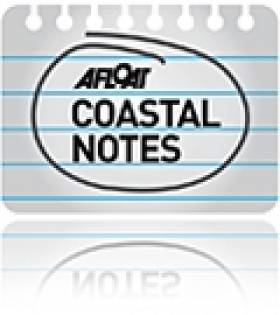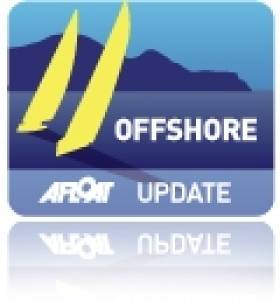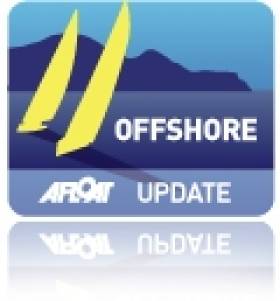Displaying items by tag: Offshore
Ireland-Bound French Yachts Avoid Danger Off Dorset
#Offshore - A fleet of 20 French yachts racing to Ireland narrowly avoided sailing into serious trouble off the Dorset coast earlier this week.
As BBC News reports, UK coastguard authorities scrambled to warn the yachts via emergency broadcast that they were headed towards an exclusion zone set up for a live firing exercise at Lulworth Ranges.
"It looks like there was a slight error made by the French authorities," said a coastguard spokesperson, who confirmed that the yachts were diverted from their dangerous course after contacting the race director.
According to Practical Boat Owner, the yachts were competing in the Normandy Channel Race which began on Sunday 14 April and continues till this Friday evening.
The race route to and from Caen in northern France traverses a triangle across the Celtic Sea, past the most southwesterly tip of Cornwall, via Tuskar Rock and Fastnet Rock.
Track RCYC's David Kenefick in Solo Arrimer Race Here!
Follow David Kenefick's progress in his final qualification race for this Summer's figaro race. Today's race at 320nm miles is the longest the Crosshaven sailor will have completed to date. He's also lining up against some of the best French skippers. more here.
Tánaiste Signs New Maritime Boundary Agreement
#MaritimeBorder - Tánaiste and Minister for Foreign Affairs Eamon Gilmore has signed a new agreement that establishes a fixed maritime boundary between the UK and Ireland's offshore areas, as The Irish Times reports.
Gilmore put pen to paper on the deal with British ambassador to Ireland Dominick Chilcott that finalises a single boundary between the Exclusive Economic Zones (EEZ) and continental shelves of both countries.
The agreement is expected to ease development of offshore energy projects, as well as improve fisheries protection and marine conservation in the EEZ, which lies above the continental shelf between 12 and 200 nautical miles off the coast.
However, despite the new deal, Ireland and Britain's differing claims over Rockall in the North Atlantic remain.
The small rocky islet, 228 nautical miles northwest of Donegal, is also claimed by Denmark and Iceland.
American Sailing's Great Survivor
#offshoresailing – There were four of them, back in 1968 in New York. There was Dick Nye (1903-1988). Briefly a theatrical hopeful, he'd got no further than spear carrier in an opera. But Broadway's loss was Wall Street's gain – the ebullient Nye had a stellar career in the wheelings and dealings of mergers and acquisitions and takeover battles, and this funded a love of offshore racing which he hadn't discovered until he was 44 .
Also present was his son Richard B Nye, business colleague and longtime shipmate in a hugely successful shared offshore racing career on both sides of the Atlantic, and across it. "Richard was the detail guy. Richard could remember every tack and sail combination on every race they had ever sailed. I only exaggerate a little. Between the two of them, they got maximum performance out of boat and crew."
The speaker is Sheila McCurdy, Commodore of the Cruising Club of America 2011-2012. She knew the Nyes well and sailed with them too, as she is the daughter of the third man present, yacht designer Jim McCurdy (1922-1994). Having served his time with the great Philip Rhodes, rising to head the Rhodes office's sailboat division, he had now set up his own partnership with his former boss's son Body Rhodes, and a new 48ft offshore racer for Dick and Richard Nye was one of McCurdy & Rhodes' first commissions.
McCurdy worked harmoniously with the Nyes. In 1955 in the Rhodes office, he had overseen the creation of their previous boat, the 54ft yawl Carina II, which had won both the 1955 and the 1957 Fastnets overall, and her class in the Bermuda Race too, plus a couple of Transatlantics. Carina II had been and still was a great boat, but the CCA rule had moved on. Being a beamy centreboard yawl had been a rating disadvantage under the RORC Rule, which made Carina II's Fastnet double all the more remarkable. But by 1968 it no longer conferred any advantage under the American rule either, something which was expected to be emphasised with the new International Offshore Rule.
It was hoped this ground-breaking global measurement rule would be unveiled by 1970. However, the Nyes - once they'd decided to move - were men in a hurry, and in August 1968 with Jim McCurdy they finalized a design which they reckoned would be a useful template for those framing the IOR. It was that and more.
The boat which emerged from their deliberations became the fourth member of the quartet, a personality in her own right. And with the death of Richard B Nye on March 14th at the age of 81, only Carina is left - American sailing's great survivor. She is still winning major offshore races in her fifth decade, still giving enormous pleasure to all who sail on her, and comfortably belying her age of 44 with timeless good looks.
She was built in aluminium, and kept as simple as possible. How about teak laid decks, even with their inevitable weight? As they say on Wall Street – fuggedaboudit. It wasn't that the Nyes were tight with the money, though they did shop around for value – their previous Carina had been built in Germany in a yard near Hamburg, as that offered the best deal at the time. But they readily spent money on the boat, particularly on the sails and rig, when genuine benefit would result.
And Jim McCurdy had an interesting approach to expenditure in building one-off yachts. Despite being of Ulster-Scots descent – you'll find McCurdys on Rathlin Island, and they're big around Ballymena and in The Glens – Jim McCurdy had a refreshingly open attitude to budgets, at variance with the popular perception of the Ulster-Scots' reputation for parsimony. In response to questions from Arthur Beiser for the latter's authorative book The Proper Yacht (Second Edition 1978), McCurdy suggested that anyone thinking of building the dreamship should consider "throwing financial responsibility to the winds and grabbing your dream as it slips away into an even more unfriendly future. There are those who have acted in this fashion and their irresponsibility turned, in fact, into wisdom that produced a great reward in enjoyment of sailing".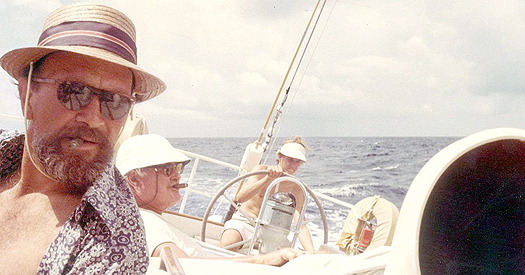
Jim McCurdy and Dick Nye aboard Carina in the 1972 Transatlantic Race to Spain, which they won by a huge margin. They were both great men for their cigars, earned here after a tactical gamble had paid off in spades.
Another time, he commented that those who concentrated on saving the pennies at every stage ended up spending more and achieving less than those who took the broader more generous view. Certainly with the previous Carina, when the Nyes' Wall Street speciality financial services firm was a much more modest operation than had become by 1968, the yacht style finish was to the highest standard, with all the trimmings. But with the sparse new boat, all was in line with the purpose of providing performance with just the basics of comfort needed by dedicated amateur crews for long races, and this remarkably handsome yet decidedly non-yachty sloop made her international debut at Cork in July 1969.
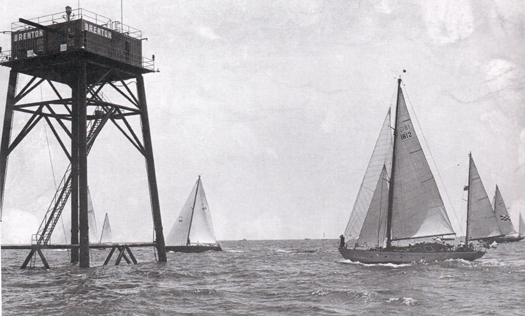
Shortly after the start of the 1969 Transatlantic Race to Cork, with Huey Long's maxi Ondine and the new Carina leading the only Irish entry, Perry Greer's Helen of Howth, past the Brenton Reef Light Tower. Photo: Tom Matthews
She'd raced Transatlantic, against a fleet which included one Irish entry, Perry Greer's John B Kearney-designed 54ft centreboard yawl Helen of Howth, which ironically had in some ways been inspired by the previous Carina. But Helen's owner was an inveterate gadgeteer and liked his cruising comforts. Even in racing trim, the Irish boat was no more than a fast cruiser, floating well below her designed waterline. The new austere Carina by contrast was very much a contender. So although in a big boat race to Cork the winner was the souped-up 12 Metre American Eagle from the 66ft S&S yawl Kialoa – Ted Turner from Jim Kilroy: there were giants in ocean racing in those days – Carina won her class in style, and her crew were enthused about her easy speed and good handling characteristics. Even today, after hundreds of thousands of miles, it's said she has never broached.
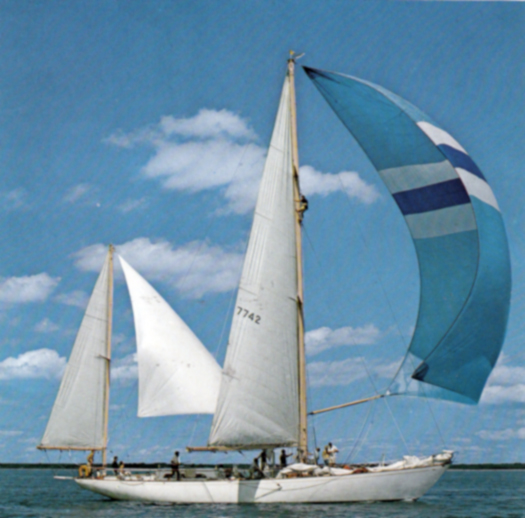
Jim Kilroy's 66ft yawl Kialoa II placed second in the 1969 Transatlantic Race to Cork.
That Cork visit resulted in Transatlantic links to the Nyes which two years later in 1971 had the 22-year-old Ron Cudmore sail as crew on Carina in a fast delivery passage across the Atlantic. Dick Nye wanted to get to the 1971 Admirals Cup, Ron wanted to get home from the US, and as no Transatlantic Race was scheduled, they could sail the northern Great Circle route with no mandatory waypoint to keep them clear of ice. Carina zapped across in just over a fortnight on the open ocean - "Fast and very cold," as Ron recalls. "great boat, awesome skipper".
Another Irish sailor who particularly remembers her arriving in Crosshaven back in 1969 is Neil Kenefick. Aged 11 at the time, he and his father were invited to sail on Carina from Cork to Kinsale as the Nyes fitted in a tiny bit of cruising before heading off for Dick Nye's favourite regatta, Cowes Week, which included the Admirals Cup in which Carina was a member of the winning American Team.
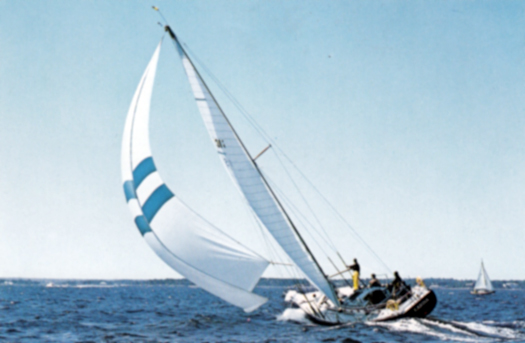
Carina on the Solent in 1969, when she was a member of the winning American Admiral's Cup team. It's said that she has never broached, and here – tight spinnaker reaching under her original configuration of smaller rudder with trim tab on keel – she is giving the helmsman no problems.
Neil met up with them again in Cowes ten years later, when he himself was on the then-leading Irish Admirals Cup team aboard Golden Apple, and the Nyes were properly impressed. But Golden Apple was a 1979 Fastnet casualty, along with Ireland's Admirals Cup hopes, whereas Carina went round in style with three generations of Nyes aboard – Richard B's son Jonathan was in the crew. At the height of the gale Dick Nye, aged 76, roped himself into the cockpit the better to savour this storm of storms: "This is GREAT" he bellowed, "truly utterly GREAT!"
The boat had already won a Bermuda Race overall, and in 1982 with the old man finally feeling his years and retired from offshore racing, Richard Nye sailed as skipper on his own and Carina won the Bermuda Race overall again. The successes continued, but by the mid '90s the junior Nye was looking back on fifty years of active offshore racing. So Carina found an excellent new home with Rives Potts, whose CV included crewing for Dennis Conner in 12 Metres, and very varied boatyard work – it was he who had done most of the work in the angle-grinder event in Bob Derecktor's famous yard when Carina was given an up-dated keel and rudder profile to Scott Kauffmann designs in 1978.
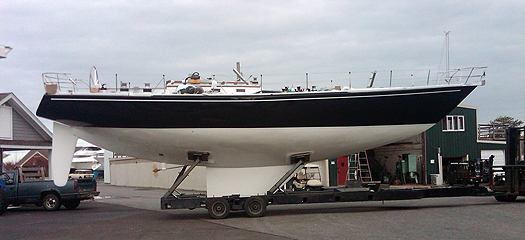
Carina's hull profile as it is today, with the new keel-rudder configuration to Scott Kauffmann designs fitted in 1978. Originally she's had a skeg-hung rudder with a trim tab on the keel. Photo: Rives Potts
Since then in Potts ownership, the only significant change has been a new mast in carbon. It has been noted that it lessens pitching. But other than that, this is still the same Carina, immaculately and lovingly maintained. In 2010 she won the Bermuda Race overall, then in 2011 she came cross the Atlantic and won Class 5 and placed fifth overall in the record fleet in the Rolex Fastnet Race. Then she simply sailed straight off to Sydney under the command of the next generation, and got sixth in class in the Hobart Race and won the informal "father-son" division, and then sailed on round the world with a particularly impressive east-west crossing of the Indian Ocean from Perth to Cape Town to get back to the US just in time for the Bermuda Race 2012, and she won overall in that yet again.
She won't be in the Fastnet this year, but it's likely she'll be back in 2015. Rives Potts is a flag officer of the New York YC, which will sending a fleet across for the Bicentennial of the Royal Yacht Squadron. And in that fleet, the boat for true sailors will be this modest 46-year-old black sloop, American sailing's great survivor, a global superstar.
THE HIPPY HAPPY MIRROR DINGHY
Did you know there used to be Mirror dinghies for hippies, driven by flower power? Believe me, there were – we bought one for family use back in 1977 from a former suburban hippy round Dun Laoghaire way. Instead of a simple paint job for the hull, she was decorated in flowers from end to end.
The guy we bought her from was Norman Long. These day, he is of course F. Norman Long, senior sailor emeritus, pillar of the yachting establishment, and basking in the deserved glow of having played a key role – along with Theo and Avril Harris - of getting the annual frostbite series inaugurated under the auspices of the Dun Laoghaire Motor Yacht Club, way back in 1974 or even earlier.
But in his more relaxed moments yonks ago, Norman would have dreamt of making the scene in San Francisco. I don't think he got there, yet he grew his hair long, and he painted his boat with psychedelic flowers on a pink background. But regrettably, it wasn't that which drew us to the boat. We simply wanted a Mirror dinghy because it offered so much for an impecunious family with two small children and another on the way, and Norman's was for sale as he was getting involved with offshore racing.
The Mirror was the right choice for us. They're great little big-hearted boats, one of the cleverest dinghy design concepts of all time. She gave us two happy summers and was everything we needed for local mini-cruises – some boats twice the size couldn't carry as many people - and the very occasional race. But it wasn't until the flowers had gone that we made our debut with our new pride-and-joy. We smuggled her back home on the roof of our battered little car, and hid her in the garage - it hadn't become an office in those days. When she reappeared, immaculate yacht white with a neat dark green boot-top – a proper boot-top, not silly stripes – the neighbours thought it was a different boat entirely.

Mirror action at Rosses Point in Sligo. This year the class is celebrating its Golden Jubilee, and the Worlds are at Lough Derg in August.
Photo: Bryan Armstrong
These fond memories are evoked by the fact that this month marks the Golden Jubilee of the Mirror Class Assocation. It was actually 1962 when DIY guru Barry Bucknell and ace dinghy designer Jack Holt pooled their considerable talents to produce the smallest possible boat which could do just about everything, and they succeeded brilliantly. Of course they're now mainly known for their racing, but for simply sailing they're great too, and seaworthy with it – one intrepid Mirror sailor managed to get all the way from Shropshire in England across Europe to the Black Sea.
The essence of the design is that it was dictated by what could be done with marine ply by amateur builders. The stitch-and-glue technique conferred strength and shape, while the need for economy and internal space dictated the pram bow.
Inevitably over the years, racing demands have meant that people have lost sight of the original very basic concept. For instance, they now have bermudan rig, where originally they'd a sensible sliding gunter set-up with all the spars stowable within the hull when un-rigged, which was very user friendly.
Less user-friendly was the need to keep weight and price down, thus they were built with ultra-light inexpensive plywood, of marine standard but pushing it a bit. It couldn't be neglected at all. So in time there were attempts to build competitive boats in lower maintenance glassfibre, and when the Worlds were held in Ireland in 2001, the Australians turned up with plastic boats which did the business.
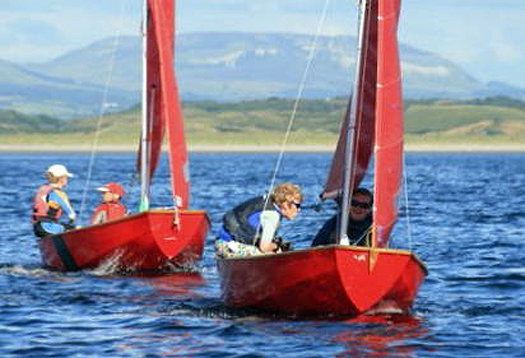
The shape of the Mirror dinghy is dictated by the demands of plywood construction, and the need for economy and light weight.
Photo: Bryan Armstrong
But in the long run, it's absurd to use fibreglass to build boats whose shape was created in the first place by the unique demands of plywood construction, utilising a totally hard chine shape. We mentioned that here some weeks ago in considering the 30ft van de Stadt-designed Royal Cape ODs. Those slippy little plywood sea sleds had given so much sport that somebody though it would be a great idea to build them in more durable glassfibre. But only four were built in plastic as the absurdity of sticking to the confines of a totally plywood design concept became obvious.
It should be possible to create a design which has the Mirror's excellent roominess, attractive sailing ability and compact size, while taking much greater advantage of the shape options which plastic construction offers. But of course, such a boat would need all the hassle of creating a new class, with its essential dedicated adherents. The Mirror dinghy comes with its own extraordinary ready-made hinterland of wonderful memories and great sport.
So we wish them a very happy 50th Birthday. And where does an impecunious sailing family go after two great years with a Mirror? Into a Squib of course – where else?
#isora – Preparing for the offshore racing season and especially the Dun Laoghaire to Dingle race and Fastnet Race is the subject of Wednesday's pre-season ISORA talk at the National Yacht Club on Wednesday at 7pm. 'Prof' O'Connell of North Sails Ireland will talk about "Offshore Trim and Speed" and Mick Liddy will talk about "Offshore Tactics and Navigation".
There will be a wine reception afterwards.
#roundireland – After spending last Friday night in the lee of Mount Snowdon, with 35-50 knot winds and rough seas off the Welsh coast, Team Oman Sail called it a day on their ill-fated record attempt and headed back to France early on Saturday morning.
Steve Fossett's 1993 record lives on but Irish crew man Damian Foxall has promised to return and make another attempt.
If the ultra fast MOD70 trimaran gets the right conditions it is estimated as much as ten hours can be shaved off the 1993 Lakota 44 hour record, thanks to new sailing technology.
For now though, Omansail continues its three week training session (part of a build up to the Round Europe race) back in Lorient, France.
'On Tuesday we are out testing with the new Tri Prince de Bretagne', Foxall told Afloat.ie
The following week three MOD 70's go to the training centre in PLF, Oman Sail will line up with Gitana and hopefully Jean Pierre Dick's new MOD 70 Paprec Virbac.
'We've a good season ahead, a couple of short Breton races, three more training sessions, then the Round Europe with a stopover in Dublin, the Fastnet'
The miles flow easy under the MOD 70 hulls and with Foxall's commitment it look's like Omansail will certainly be back for the Fossett record.
Round Ireland Speed Sailing Record Attempt Abandoned
This morning's Round Ireland record bid has been abandoned and Damian Foxall and the crew of the MOD70 who sheltered off the Welsh coast in freezing conditions last night are returning to Lorient, France directly this morning. The disappointing news came from Skipper Sidney Gavignet in an email to World Speed sailing commissioner Chris Moore who was standing by to officiallly start the record challenge at the National Yacht Club in Dun Laoghaire this morning.
Dear Chris,
We will not attempt the record this time, we are aiming back to Lorient. Conditions are "almost" ok, but we prefer to play the safe decision. Hopefully we will come back later in the year, in better conditions.
All our team thanks you a lot for all your efforts, we regret we won't see you but it will happen later.
Best regards
Sidney Gavignet
Gavignet, Foxall and a four man professional crew had originally targeted last Thursday as the optimum start time off the Kish lighhouse but the 1000km delivery trip from Lorient was delayed by 24 hours. They eventually left the French port at tea time on Thursday and endured strong winds and heavy seas on their voyage across the channel and up the Irish Sea, eventually running for shelter under bare pole into Cardigan Bay yesterday (Friday) afternoon.
Last night the crew were enjoying their first hot meal in 24 hours and were obviously considering their options overnight.
"Still gusting 40 knots, but flat seas. It is very cold, snow on the mountains. Right now Sidney and Thomas Le Breton are having their first hot meal of the day! Spirits are up and all is well"
At 07.18 this morning they were heading for home. We look forward to seeing them back near Irish shores again soon.
Read WM Nixon's Saturday Sailing blog on all the past Round Ireland speed records dating back to 1899! Click Here.
Update from Oman Sail released on Sunday:
With a very busy training and racing season ahead, Musandam-Oman Sail's French skipper Sidney Gavignet chose safety for the crew and the boat this morning over the Round Ireland Record attempt and decided to turn back to Lorient in France where the boat is based.
The strong winds that looked set to aid Musandam-Oman Sail's attempt on the Round Ireland record proved too strong in the end and while conditions had decreased a little overnight, the wind was gusting 38knots plus and the sea state was still very rough with 4m at the Fastnet. Writing from the boat, Sidney said: "We will not attempt the record this time, we are heading back to Lorient. The conditions are 'almost' ok, but we prefer to play it safe with such a busy season ahead, our priority is the crew and boat safety. Hopefully we will come back later in the year to try for the record in better conditions."
The six-man crew had been on standby for almost 18 hours, making assessments with each weather update on the feasibility of success in their attempt on the 708 mile record, with impact on both boat and crew figuring high in their considerations.
To set a new record, Musandam-Oman Sail had to complete the circuit in less than 44 hours and 42 minutes, the record set by sailor, balloonist and adventurer Steve Fossett on his 60 foot trimaran Lakota in 1993.
With a new crew featuring experienced internationals Neal McDonald, Damian Foxall and Thomas Le Breton and Omani nationals Fahad Al Hasni and Ahmed Al Maamari, the Round Ireland record attempt marked their first competitive activity, with this race against the clock seen as good preparation for a busy season of racing in Europe.
#roundirelandrecord – A change in weather forecast has led Kerry sailor Damian Foxall to postpone his bid to beat the Round Ireland speed sailing record for 24 hours. The Oman Sail trimaran craft skippered by Sidney Gavignet is now set to arrive from France on Friday 22nd off the Kish lighthouse on Dublin Bay. The 20-year old record set by Steve Fossett in 1993 stands at 44 hours.
Foxall and his five man crew (who may yet be joined by an Irish sailor) have identified strong easterly winds gusting to over 40 knots to start the record bid. XC weather forecasts strong East South East winds for 72 hours from late on Thursday.
The National Yacht Club in Dun Laoghaire will officiate the World Speed Sailing Record bid under its Irish commissioner Chris Moore.
No Host Port for Ireland in 2013 Figaro
#Figaro - The course for this year's Solitaire du Figaro has been finalised - with no Irish port in the lineup.
The Daily Sail details the four legs of the 44th edition of the prestigious and challenging single-handed offshore race, that will take the fleet from Bordeaux to Porto, Gijón, Roscoff and Dieppe - with no changes from the course unveiled in December.
But despite indications that Ireland would have a host port on the race route, following previous stop-overs on Kinsale, Dingle, Howth, Crosshaven and Dun Laoghaire, it appears this summer's running will be a purely continental event.
Even so, Ireland will be represented among the competing fleet by the brother of last year's Sailor of the Year David Kenefick, who is set to make his Figaro debut.
The Cork Harbour helmsman, who came second in the La Grande Motte recently, discussed race tactics as he steps up his training ahead of the race from 2-23 June.
Fastnet Oil Takes Option On 'Deep Kinsale Prospect'
#Oil - Fastnet Oil & Gas has executed its exclusive option agreement to farm into its Deep Kinsale Prospect beneath the Kinsale Head Gas Field.
The option agreement with Petronas subsidiary Kinsale Energy is confined to geological formations below 4,000 feet subsea. Fastnet will conduct a 3D seismic survey over 500 sq km in the Celtic Sea prospect by the end of the year as well as complete necessary geological and engineering studies.
The agreement also gives Fastnet an exclusive option to test the geologically similar Purbecko-Wealden reservoirs productive in Barryroe, a prospect that has proven a bounty for Providence Resources.
Fastnet chair Cathal Friel said: "We are delighted to have added an exclusive option to farm into and potentially drill the Deep Kinsale Prospect in 2014.
"It represents an attractive addition to our Irish portfolio as we have long held a belief that Deep Kinsale offers the potential to yield up another significant hydrocarbon discovery offshore Ireland. This belief has been further strengthened by the successful appraisal of Barryroe in 2012, which is geologically analogous to Deep Kinsale.
"We greatly look forward to working in close cooperation with our colleagues at Kinsale Energy, as we collectively seek to de-risk the prospect for drilling."
As previously reported on Afloat.ie, Fastnet Oil & Gas announced in December its plans to spend more than €20 million on the Celtic Sea's biggest ever seismic study on blocks off the south coast which were drilled in the 1980s and later abandoned.
New techniques in the oil industry are now allowing previously unviable resources to be extracted, as fellow prospectors Petrel Resources are planning to do off the Kerry coast.





























